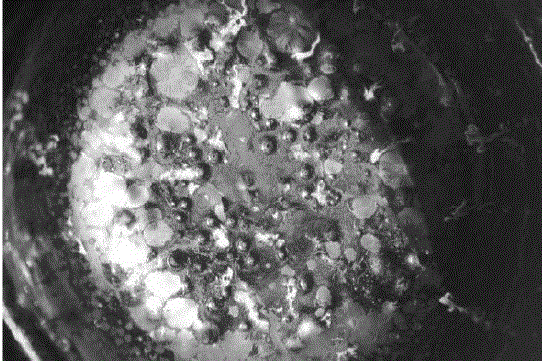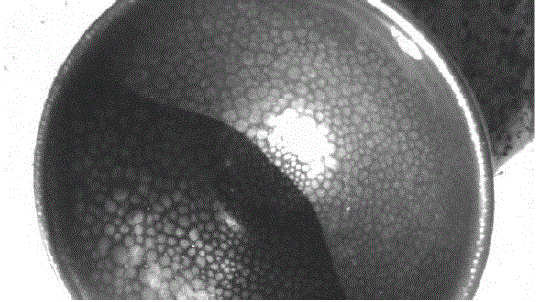Tianmu Glazed Porcelain and Its Firing Method
A technology of Tianmu glaze and glaze, which is applied in the field of preparation of high-end artistic ceramics, and can solve the problems of loss of Tianmu glaze formula and firing process, low yield, and difficulty in forming discoloration halos, etc.
- Summary
- Abstract
- Description
- Claims
- Application Information
AI Technical Summary
Problems solved by technology
Method used
Image
Examples
Embodiment 1
[0032] Examples 1 to 5 are specific examples of the Tianmu glaze porcelain and its firing method of the present invention, among which Example 1 is the best example.
[0033] Example 1
[0034] The glaze of this embodiment includes the following chemical composition by mass percentage: SiO 2 63.4 parts, Al 2 O 3 16.01, Fe 2 O 3 9.9 parts, CaO 5.68 parts, MgO 2.71 parts, TiO 2 For 2.35 copies, K 2 O 3.35 parts, Na 2 O is 2.68 parts, ZnO 1.2 parts, SnO 2 1.6 copies, P 2 O 5 1.4 copies.
[0035] The firing method of this embodiment includes the following steps:
[0036] 1) Heating up: After mixing the glaze according to the chemical components, apply the glaze on the body with a thickness of 0.6~1mm, and the temperature will be increased to 400℃ within 3 hours; from 400℃ to 1020℃, the temperature will be increased by 80℃ per hour Heating at a rate of temperature; from 1020°C to 1200°C, at a rate of 60°C per hour; from 1200°C to 1300°C, at a rate of 30°C per hour; then keep at 1300°C f...
Embodiment 2
[0040] The glaze of this embodiment includes the following chemical composition by mass percentage: SiO 2 For 63 parts, Al 2 O 3 16.5 parts, Fe 2 O 3 Is 9.5 parts, CaO is 5.5 parts, MgO is 3 parts, TiO 2 For 2 copies, K 2 O is 3.5 parts, Na 2 O is 2.5 parts, ZnO is 1.5 parts, SnO 2 1.5 copies, P 2 O 5 For 1 serving.
[0041] The firing method of this embodiment includes the following steps:
[0042] 1) Heating up: After mixing the glaze according to the chemical components, apply the glaze on the body with a thickness of 0.8~1mm, and the temperature will be increased to 390℃ within 2 hours; from 390℃ to 1015℃, the temperature will be increased by 70℃ per hour The temperature is increased at the rate of heating; from 1015°C to 1195°C, at a rate of 40°C per hour; from 1195°C to 1305°C, at a rate of 30°C per hour; then heat preservation at 1305°C for 6 hours;
[0043] 2) Cooling down: After the heat preservation is over, cool down from 1305°C to 1185°C within 40~45 minutes; reheat, heat...
Embodiment 3
[0046] The glaze of this embodiment includes the following chemical composition by mass percentage: SiO 2 63.8 parts, Al 2 O 3 16 parts, Fe 2 O 3 10 parts, 5.5 parts of CaO, 3 parts of MgO, TiO 2 2.5 copies, K 2 O3 parts, Na 2 O3 part, ZnO1 part, SnO 2 2 servings, P 2 O 5 1.5 copies.
[0047] The firing method of this embodiment includes the following steps:
[0048] 1) Heating up: After mixing the glaze according to the chemical components, apply the glaze on the body with a thickness of 1~1.5mm, and the temperature will be raised to 380℃ within 3 hours; from 380℃ to 1030℃, the temperature will be increased by 60 per hour Heating at a rate of ℃; heating from 1030℃ to 1210℃, heating at a rate of 60℃ per hour; heating from 1210℃ to 1310℃, heating at a rate of 30℃ per hour; then holding at 1310℃ for 4 hours ;
[0049] 2) Cooling down: After the heat preservation is over, the temperature will be reduced from 1310°C to 1200°C within 30 to 35 minutes; heating again, the temperature wil...
PUM
| Property | Measurement | Unit |
|---|---|---|
| thickness | aaaaa | aaaaa |
Abstract
Description
Claims
Application Information
 Login to View More
Login to View More - R&D
- Intellectual Property
- Life Sciences
- Materials
- Tech Scout
- Unparalleled Data Quality
- Higher Quality Content
- 60% Fewer Hallucinations
Browse by: Latest US Patents, China's latest patents, Technical Efficacy Thesaurus, Application Domain, Technology Topic, Popular Technical Reports.
© 2025 PatSnap. All rights reserved.Legal|Privacy policy|Modern Slavery Act Transparency Statement|Sitemap|About US| Contact US: help@patsnap.com



